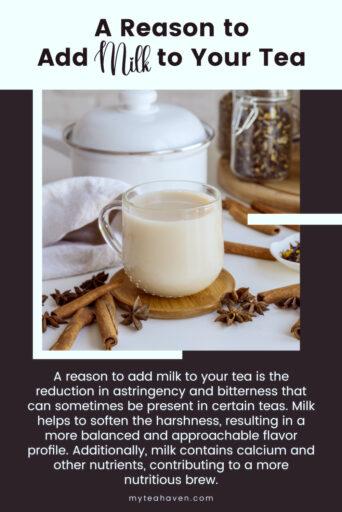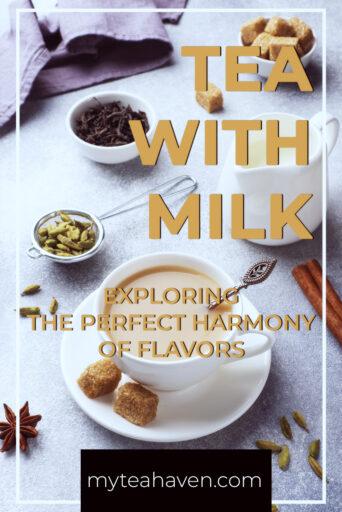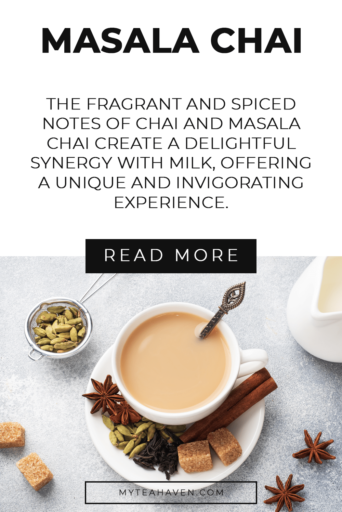The Creamy Companion: Why Tea With Milk is Worth the Pour
Exploring the Perfect Blend
Tea’s rich history, diverse flavors, and soothing properties have made it a cherished part of my daily routine. In my quest to discover the perfect cup of tea, I’ve investigated various tea traditions and explored countless brewing methods. One particular aspect that often sparks lively debate among tea lovers is the addition of milk. Whether you’re for or against it, you likely have an opinion! Today we’ll discuss the controversial topic, so grab a cuppa and let’s find out what the big deal is!
We are a participant in the Amazon Services LLC Associates Program, an affiliate advertising program designed to provide a means for us to earn fees by linking to Amazon.com and related sites. This post may contain affiliate links which means we may receive a commission, at no cost to you, for purchases made using our links. Please see my disclosure to learn more. Unless otherwise stated, all prices are in US$.
History of Having Tea with Milk
The roots of tea can be traced back to ancient China, where it was initially consumed without the addition of milk. However, the introduction of tea to the Western world, particularly through the British Empire, brought about a significant change in tea culture.
The British, renowned for their love of tea, began adding milk to their brews as a way to temper the strong flavors of the teas they imported.
Over time, the tradition of adding milk gained popularity in various parts of the world, including India, where the beloved masala chai emerged.
Today, it’s enjoyed by people from different cultures, each adding their own unique twist to this delightful blend.

Types of Tea that Pair Well with Milk
It’s true that not all teas pair very well with milk. Some teas are inherently better suited for this combination, as they complement each other’s flavors and textures. Classic black teas, such as Earl Grey or English Breakfast, are popular choices for enjoying with milk. Their robust profiles harmonize beautifully with the creamy richness that milk brings.
Another variety that is renowned for its affinity with milk is Assam. This bold and malty Indian tea holds up well to the addition of milk, resulting in a full-bodied and comforting brew. Additionally, the fragrant and spiced notes of chai and masala chai create a delightful synergy with milk, offering a unique and invigorating experience.

HANDPICK Organic English Breakfast Black Tea Bags
Elevate your mornings with our strong and robust English tea, sourced directly from high-elevated tea plantations in India. This delicious, caffeinated black tea provides a delightful kickstart to your day. Loaded with nutritious benefits, it stands apart from other herbal teas and can even be used to brew Kombucha tea, adding to its versatility.
Benefits of Adding Milk

The inclusion of milk offers more than just a change in taste; it brings several advantages to the table. One of the primary benefits is the enhanced creaminess and texture that milk imparts to the brew. It adds a velvety smoothness that can turn an ordinary cup of tea into a luxurious treat.
Another advantage is the reduction in astringency and bitterness that can sometimes be present in certain teas. Milk helps to soften the harshness, resulting in a more balanced and approachable flavor profile. Additionally, milk contains calcium and other nutrients, contributing to a more nutritious brew.
How to Add Milk Properly
To achieve the perfect balance, it’s essential to follow a few guidelines when incorporating milk into your brew. Firstly, timing and temperature play a crucial role. It’s best to add the milk after the tea has been steeped to avoid interfering with the extraction process. As for temperature, make sure the tea is hot enough to warm the milk without cooling it down excessively.
Brewing techniques also come into play. If using bags, remove the bag before adding milk to ensure a smooth infusion. When brewing loose-leaf, strain it into a separate cup or pot before adding the milk. This way, you have more control over the tea-to-milk ratio, allowing you to customize the strength of the blend.
For those who enjoy a frothy cup of tea, mastering the art of milk frothing can take the experience to new heights. Frothed milk adds a delightful layer of texture and visual appeal to your drink, elevating it to a café-worthy indulgence!
Milk Tea Recipes and Variations
This combination offers a world of possibilities when it comes to creative recipes and variations. The traditional milk tea recipe involves brewing a strong cup of tea and adding warm milk and sweetener to taste. That being said, don’t be afraid to experiment and infuse your version with additional flavors.
For a touch of decadence, try incorporating flavors like vanilla, cinnamon, or cardamom into your drink. These spices add depth and complexity, transforming a simple cup of tea into a fragrant and invigorating delight. You can also explore different types of milk, such as almond, oat, or coconut, for unique flavor combinations.


HANDPICK Loose Leaf Chai Tea
Indulge in the exquisite aroma and flavors of our Aromatic Indian Spices loose tea blend. Immerse yourself in the essence of authentic Indian spices meticulously infused with the bold and robust Assam CTC chai tea. This enchanting fusion offers a truly invigorating experience, as crushed cardamom, ginger, cloves, cinnamon, and black pepper come together.
Controversies Surrounding Tea With Milk
As with any culinary tradition, it’s not without its controversies. Cultural perspectives and traditions often shape the way tea is enjoyed in different parts of the world. Some people argue that adding milk disrupts the authenticity and purity of the brew, diluting its true essence. These purists advocate for savoring tea in its unadulterated form, appreciating its nuanced flavors without any additions.
The debates on authenticity and purity raise interesting questions about the impact of milk on tea appreciation. Is it possible to fully grasp the subtleties of a tea’s flavor profile when milk alters its composition?
While this remains a subject of ongoing discussion, it ultimately comes down to personal preferences and the enjoyment derived from the tea-drinking experience.
Reasons to Avoid Adding Milk to Tea
While it has its charm, there are valid reasons why some individuals choose to avoid this combination.

For those who value the authenticity and purity of tea, adding milk can be seen as a deviation from the true essence of the brew. It’s believed that tea should be appreciated for its unique flavors and complexities, untainted by external influences.
Tea appreciation can be seen as a fine art, with each brew offering a distinct sensory experience. By forgoing the addition of milk, people can fully immerse themselves in the delicate nuances of the tea’s aroma, taste, and mouthfeel. It’s an opportunity to embrace the purity of the tea leaves and connect with the beverage on a deeper level.
Alternatives to Milk for Your Tea
For those who prefer to steer clear of milk but still desire a creamy touch to their brew, various alternatives can be explored. Non-dairy milk options, such as almond milk, soy milk, or oat milk, offer a plant-based alternative that can mimic the creaminess of traditional milk. These alternatives cater to individuals with dietary restrictions or those who simply prefer a vegan lifestyle.
In addition to non-dairy milk, natural sweeteners and flavorings can be used to enhance the tea-drinking experience. Honey, agave syrup, or maple syrup can add a touch of sweetness, while spices like cinnamon or nutmeg can infuse the tea with warm and comforting notes. These alternatives allow for customization while keeping the integrity of the tea intact.

Personal Preferences
At the end of the day, personal preferences should be the guiding force behind your tea choices. Tea with milk is all about creating a cup that brings you joy and comfort. It’s an opportunity to experiment, adapt, and tailor your tea experience to suit your unique taste buds.
Whether you choose to embrace the creaminess of milk or prefer your brew in its purest form, there’s no right or wrong way to enjoy it. The beauty of tea lies in its versatility, accommodating a wide range of tastes and preferences. Never be afraid to embark on your own journey, exploring the endless possibilities and discovering the tea with milk combination that resonates with you.
A Few Final Thoughts

Having your tea with milk is a fusion of tradition, culture, and personal preferences. It’s a delightful blend that invites us to explore the diverse world of tea while adding a touch of indulgence to our daily routines. Whether you choose to embrace the creamy richness or a more unadulterated tea experience, the choice is yours.
As tea lovers, we have the privilege of embarking on a journey of discovery, exploring different teas, brewing techniques, and flavor combinations. Let us celebrate the art of tea and savor every sip, whether with or without milk, as we embark on a lifelong quest to find the perfect blend.
Some Questions You Might Have
- Is it necessary to add milk to tea?
Adding milk is purely a matter of personal preference. Some enjoy the creaminess and added flavors it brings, while others prefer the purity of tea without any additions.
- Does adding milk alter the taste?
Yes, it can change the taste of tea. It adds creaminess, reduces bitterness, and can introduce new flavor notes depending on the type of tea and the milk used.
- What are some alternatives to milk?
Non-dairy options, such as almond, soy, or oat milk, can be used as alternatives. Natural sweeteners like honey or maple syrup can also add a touch of sweetness.
- Can I add milk to any type of tea?
While adding milk is most commonly associated with black teas, it can be added to other teas as well. Experiment with different types of tea and find the combinations that suit your taste preferences.
- What is the best way to incorporate milk into tea?
Add it after the tea has been steeped and ensure the temperature is hot enough to warm the milk without cooling it down excessively. The amount of milk can be adjusted to personal preference.







